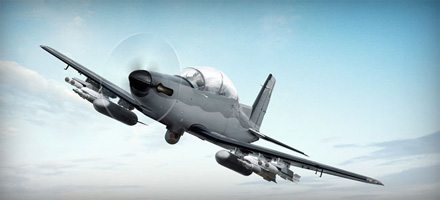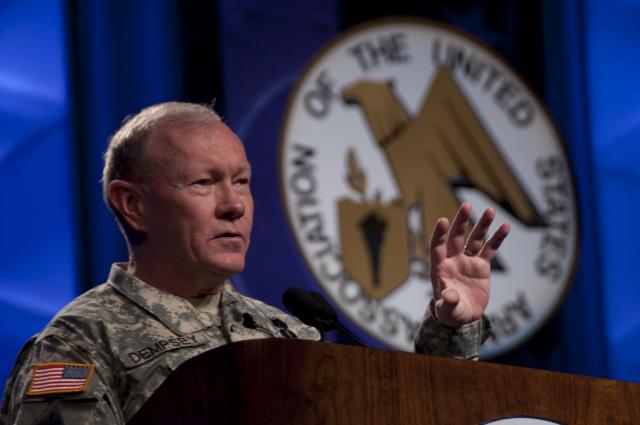The capability gap of a light attack aircraft came to the attention of the U.S. Central Command (CENTCOM) in 2007. Against the jet-only conventional wisdom, CENTCOM started preliminary efforts to acquire a robust, cost-effective, easy to maintain and heavily armed irregular warfare platform to carry out close air support (CAS) and counter-insurgency (COIN) missions.
After a full year of evaluation between the finalists Hawker Beechcraft AT-6B and Embraer A-29B Super Tucano, the U.S. Air Force (USAF) announced on December 30th that Sierra Nevada Corporation (SNC) as primary contractor was the winner of the highly contentious Light Air Support (LAS) competition. The $355 million contract awarded to the SNC/Embraer team details the delivery of 20 aircraft, ground training devices and associated equipment to train pilots from allied nations commencing with Afghanistan.
Since September, many unexpected changes have been made to the original USAF requirements. At the start of the competition, the Light Attack Armed Reconnaissance Aircraft (LAAR) program, planned to supply up to 100 aircraft to the USAF, was paired with Light Air Support (LAS) to supply 20 aircraft to Afghan Air Force.
Nevertheless, in September the USAF backtrack on LAAR, reducing the number to 15 aircraft. The rationality behind to cut was due to the shift of the USAF priorities from establishing a dedicated COIN wing to “building partnership capacity”. The change in priorities left Hawker and the SNC/Embraer team to duck it out for LAAR’s 15 and LAS’s 20 aircraft requirement.
Hawker suffered a deathblow when in late November, without much explanation from the USAF, was suddenly dropped from the competition, apparently due to problems with its proposal. In an effort to salvage the AT-6B, Hawker resorted to the courts, suing the USAF and launched a formal complaint with the Government Accountability Office (GAO).
In mid-December, the GAO declined Hawker’s complaint and the USAF quietly awarded the contract to the SNC/Embraer team on December 22nd, but became official on December 30th. Meanwhile, waiting for the outcome of Hawker’s lawsuit and after strong negative reaction from Kansas lawmakers (Hawker’s home-state), the USAF ordered to halt work on LAS four days after the contract was awarded.
This is too much drama for such small aircraft. LAS has turn out to be another controversial acquisition program like those of the future tanker (KC-X) and the combat search and rescue-x (CSAR-X) helicopter competitions. Even though the USAF advocates transparency, there was no clear and public statement of why the AT-6B was dropped. The USAF stumbled by not clearly stating why it took the decision, now it must do so. Hawker’s credibility was also weakened by not alerting the USAF of any wrongdoing before it was dropped. Instead Hawker’s strategy, after its complaint was declined by the GAO, is to rely on strong congress supporters for a favorable resolution.

Meantime the U.S. Navy has run into difficulties of its own, by clearly preferring the Super Tucano after it took part in an evaluation phase known as Imminent Fury programme in 2009 to develop a CAS/COIN platform for special operations. Since then, congress rejected additional funds of $22 million for further development in 2010 and $17 million last October for phase II known as Combat Dragon II programme for deployment and combat confirmation of the Super Tucano’s capabilities in Afghanistan.
There is a paradox here, the Pentagon clearly wants the aircraft, but congress refuses to finance it. Congress lawmakers, this is for you: operating costs for the F-15E runs at roughly $44 thousand per flight hour, $19 thousand for the F/A-18E/F and $7 thousand F-16C/D. Paying millions of dollars more for flight patrols and to drop bombs makes absolutely no sense. There is simply no plane that can match the light attack aircraft’s capabilities of mission flexibility, air-to-ground weapons variety, and low operating cost of roughly $1 thousand per flight hour. At such low operating costs, the Super Tucano looks just as sexy as any teen fighter.
LAAR and LAS acquisition must move forward in an expeditiously madder, especially now that the U.S. Air Force and U.S. Navy have selected the same aircraft. Both services must work together because the days of which each service ran different and independent programs, without mutual cooperation must end. In the words of ex-Secretary of Defense Robert Gates “the culture of endless money” is gone.
Take the A-10 Thunderbolt II; it has survived over 20 years after the original plans to have the aircraft retired. The USAF made a conscious decision to retain its capabilities; providing a service life extension program (SLEP) upgrade the entire fleet. At an operating cost of roughly $3 thousand per flight hour, the A-10 is a remarkable example of the kind of bargain the USAF needs to operate in a low intensity conflict environment.
No doubt that the light attack aircraft envision by CENTCOM is late for the party, especially now that the Iraq war has officially ended and U.S. involvement in Afghanistan appears to be winding down. A leaner and cheaper U.S. military is coming, but we don’t have to sacrifice the meaner part. Is never too late to save our taxpayer’s money.
References
Burno, Michael and Anselmo, Joseph “LASt Chance”. Aviation Week and Space Technology, January 3, 2012: 31-32. Print Edition
Burno, Michael. “Sierra, Embraer Wins USAF LAS, Hawker Fights”. Aviation Week and Space Technology , January 3,2012,
Dorr, Robert F. “Capital Hill Rejects Light Attack Aircraft Request”. Defense Media Network, October 21, 2011,
Dorr, Robert F. “Super Tucano is Winner of Contentious Light Attack Contest”. Defense Media Network, January 3, 2012,
Trimble, Stephen. “Rivals not deterred by USAF shift on turboprop fighters”. Flight Global, September 15, 2011
Sierra Nevada Corporation. “U.S. Air Force Stop Work Order on Light Air Support Award”. Sierra Nevada Corporation, January 4, 2012










